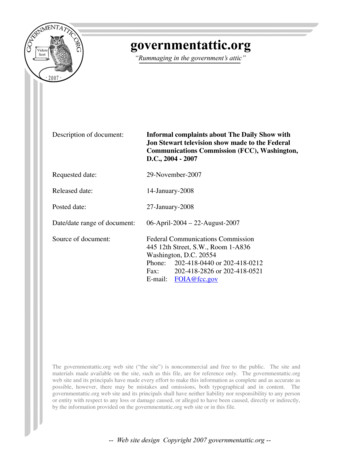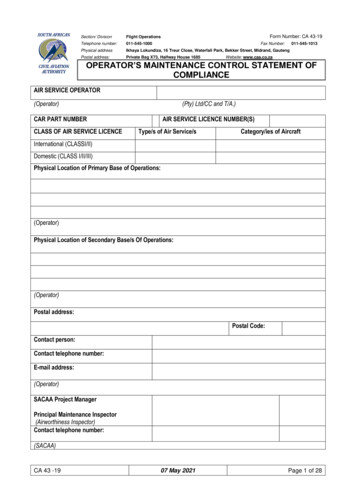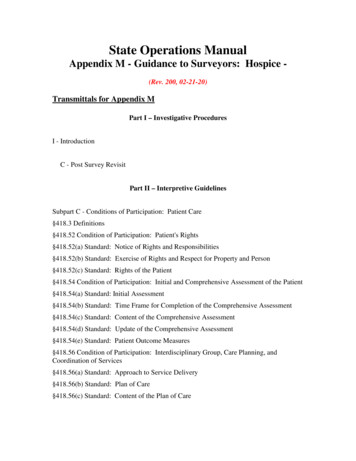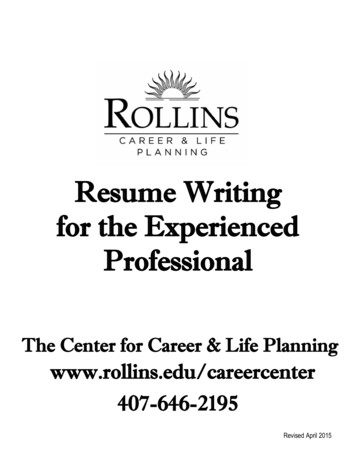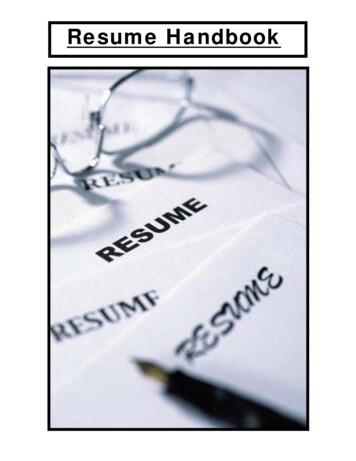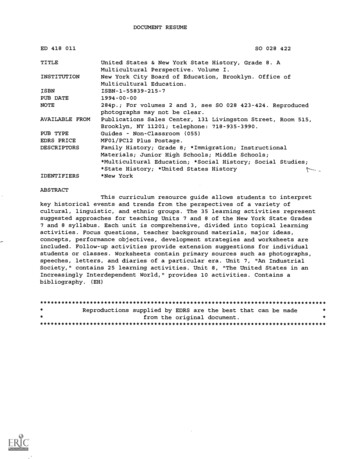
Transcription
DOCUMENT RESUMEED 418 011TITLEINSTITUTIONISBNPUB DATENOTEAVAILABLE FROMPUB TYPEEDRS PRICEDESCRIPTORSIDENTIFIERSSO 028 422United States & New York State History, Grade 8. AMulticultural Perspective. Volume I.New York City Board of Education, Brooklyn. Office ofMulticultural Education.ISBN-1-55839-215-71994-00-00284p.; For volumes 2 and 3, see SO 028 423-424. Reproducedphotographs may not be clear.Publications Sales Center, 131 Livingston Street, Room 515,Brooklyn, NY 11201; telephone: 718-935-3990.GuidesNon-Classroom (055)MF01/PC12 Plus Postage.Family History; Grade 8; *Immigration; InstructionalMaterials; Junior High Schools; Middle Schools;*Multicultural Education; *Social History; Social Studies;*State History; *United States History*New YorkABSTRACTThis curriculum resource guide allows students to interpretkey historical events and trends from the perspectives of a variety ofcultural, linguistic, and ethnic groups. The 35 learning activities representsuggested approaches for teaching Units 7 and 8 of the New York State Grades7 and 8 syllabus. Each unit is comprehensive, divided into topical learningactivities. Focus questions, teacher background materials, major ideas,concepts, performance objectives, development strategies and worksheets areincluded. Follow-up activities provide extension suggestions for individualstudents or classes. Worksheets contain primary sources such as photographs,speeches, letters, and diaries of a particular era. Unit 7, "An IndustrialSociety," contains 25 learning activities. Unit 8, "The United States in anIncreasingly Interdependent World," provides 10 activities. Contains abibliography. **********************************Reproductions supplied by EDRS are the best that can be madefrom the original ***************************************
,rGRADE 8UNITED STATESNEW YoSTATEHISTORYA MULTICULTURAL PERSPECTIVEVOLUME IirsonoANLgr.bifihrso,cN171-U.S. DEPARTMENT OF EDUCATIONOffice of Educational Research and ImprovementEDUCATIONAL RESOURCES INFORMATIONCENTER (ERIC)00c1ilf**This document has been reproduced asreceived from the person or organizationoriginating it.O Minor changes have been made toimprove reproduction quality.Points of view or opinions stated in thisdocument do not necessarily representofficial OERI position or policy. PERMISSION TO REPRODUCE ANDDISSEMINATE THIS MATERIALHAS BEEN GRANTED BYJ.BOARD OF EDUCATIONOF THE CITY OF NEW YORKBEST COPT AVAILABLETO THE EDUCATIONAL RESOURCESINFORMATION CENTER (ERIC)
GRADE 8TED STATEESEAT YORK STATHISTORYA MULTICULTURAL PERSPECTIVEVOLUME IBOARD OF EDUCATIONOF THE CITY OF NEW YORK
Copyright 1994by the Board of Education of the City of New YorkEvery effort has been made to ascertain proper ownership of copyrighted materials and obtainpermission for their use. Any omission is unintentional and will be corrected in future printingsupon proper notification.Application for permission to reprint any section of this material should be made to the Chancellor,110 Livingston Street, Brooklyn, NY 11201. Reprint of any section of this material shall carry theline, "Reprinted from Grade 8 United States and New York State History: A Multicultural Perspective,Volume I by permission of the Board of Education of the City of New York?ISBN 1-55839-215-7New York City public schools should order additional copies of this publication from the Bureau ofSupplies. Other persons or institutions may obtain copies of this publication from the PublicationsSales Center, Room 515, 131 Livingston Street, Brooklyn, NY 11201. See current catalogue forprice. For information call (718) 935-3990.It is the policy of the Board of Education of the City School District of the City of New York not todiscriminate on the basis of race, color, creed, religion, national origin, age, disability, maritalstatus, sexual orientation, or sex in its educational programs, activities, and employment policies,and to maintain an environment free of sexual harassment, as required by law. Inquiries regardingcompliance with appropriate laws may be directed to the Office of Equal Opportunity, 110Livingston Street, Room 601, Brooklyn, N.Y. 11201, Telephone: (718) 935-3320.ii4
PrefaceThe cultural diversity of New York City has increased considerably over the last twodecades. People from virtually every cultural, linguistic, and ethnic group in the worldnow come to live and work in our citytransforming it into a truly multiculturalcommunity. This trend both reflects and anticipates the worldwide movement toward aglobal society.As today's students move toward adulthood in the twenty-first century, they need to beaware of their own cultural identities, while understanding and appreciating the culturesof others. To help meet this challenge in the New York City public schools, we havebegun to develop multicultural curricula in all subject areas.Grade 8 United States and New York State History: A Multicultural Perspective gives studentsthe opportunity to interpret key historical events and trends from the perspectives of avariety of cultural, linguistic, and ethnic groups. This approach enables students toappreciate the contributions of all of our nation's peoples to history, and to acquire abody of knowledge that reflects the experiences and values representative of the manycultures that have helped construct our nation and our state. Through their activeparticipation, students will come to understand that knowledge is itself dynamic, everchanging, and open to debate.Active and critical engagement with history preserves and enriches our democratic ideals.The multicultural approach to history exemplified in these volumes will help our youngpeople to acquire the knowledge, values, and skills they will need to participate fully inthe life of our culturally complex community.BEST COPY PNAILA6LEiii5
ACKNOWLEDGMENTSGrade 8 United States and New York State History: AMulticultural Perspective is a project of the Office ofMulticultural Education. Leslie Agard-Jones, Directorof that office, provided overall supervision andRichard Sanders, P.S. 84KFrances E. Schafer, I.S. 293KElizabeth Schiff, Alternative High Schools andProgramsBurt E. Schuman, Jackson Heights-Elmhurst KehillahSteven Schwager, Manhattan Center High SchoolChristopher Sgarro, Office of InstructionalPublications, DIPDAlan Singer, Hofstra Universityguidance for the development and review of themanuscript. Eileen Neeson, Curriculum Developer,Office of Multicultural Education, assisted in themanuscript's preparation.Maria Santory Guasp, Executive Director, Division ofInstruction and Professional Development (DIPD),and Steven Tribus, Director of the Office ofCurriculum and Program Development, DIPD,assisted in the preparation of this guide.ReviewersBeryle Banfield, Metro Center, New York UniversityCarol Berotte-Joseph, City College, City Universityof New YorkJohn Paul Bianchi, Community School District 8Gerrard Bushell, Council of the City of New YorkBooker T. Coleman, Jr., Community School District 9Philip I. Freedman, Lehman College, City Universityof New YorkAsa G Hilliard III, Georgia State UniversityShirley Hune, Hunter College, City University ofFlorence A. Jackson, former Community AssistantSuperintendent, supervised the development of thecourse outline and the activities of the writing team.Arturo I. Sanchez, Office of Urban Affairs, CityUniversity of New York, and Herbert Boyd, College ofNew Rochelle, assisted in the preparation of thecourse outline and reviewed the manuscriptthroughout its preparation.New YorkJ. A. Irish, Medgar Evers College, City University ofNew YorkClement London, Fordham UniversityMaurice Martinez, Hunter College, City University ofNew YorkBarbara Omolade, City College, City. University ofNew YorkSusan Rudin, Community School District 21Elliot Salow, Office of Professional Development,Special thanks are extended to Lloyd Bromberg,Director of Social Studies, Office of Curriculum andProgram Development, for his assistance in reviewingthe outline and the manuscript.The contributions of the following people are alsogratefully acknowledged:Principal Writers.Lloyd Bromberg, DIPDNehru Kelevh, P.S. 181Eileen Neeson, Office of Multicultural EducationKristine Policiano, Community School District 6DIPDJack Salzman, Columbia UniversityVirginia Sanchez-Korrol, Brooklyn College, CityUniversity of New YorkMarietta Saravia-Shore, Columbia UniversitySusan Saskia Sassen, Columbia UniversityWilliam Seraile, Lehman College, City University ofNew YorkAlan Singer, Hofstra UniversityJoshua Sky, P.S. 230KMutsuko Tanouchi, Eastchester Union FreeSchool DistrictMarta Vega, Caribbean Culture CenterRue 7Alia Watkins, United Parents AssociationContributing WritersMelanie Banks, P.S. 332KStuart Benas, Edward R. Murrow High SchoolSumner Braunstein, Teacher (retired)Geoffrey Cabat, Seward Park High SchoolElaine Davis, P.S. 116QSharon Dennis, P.S. 8XMargaret Docherty, B.A.S.I.S.Richard Dodici, J.H.S. 217QRichard Forman, Samuel J. Tilden High SchoolSteven Kuntz, St. John's UniversityAndrea Martin-Ricketts, P.S. 30QAndrea Metzger, I.S. 115Alaire Mitchell, ConsultantJoseph Nwabueze, J.H.S. 275KMarvin Polansky, I.S. 55KEvelyn Richman, Community School District 29Susan Rudin, Community School District 21Marietta Saravia-Shore, Columbia UniversityThis manuscript was prepared for publication by theOffice of Instructional Publications, Nicholas A.Aiello, Director; Regina Paleski, Copy Chief; KentBeaty, Supervisor of Production Administration. Theproject editor was Christopher Sgarro. Thepermissisons editor was Dan Mausner. Mr. Beatydesigned the book. Dan Baxter illustrated the cover.Heidi Lanino, Cor Hazelaar and Emily Baerga assistedwith illustration, formatting, and paste-up.iv6EST COPY AVARILA 11E
Introduction*United States and New York State History:A Multicultural PerspectiveThe diversity of New York State's population isincreasingethnically, culturally, andlinguistically. Today, most classrooms includestudents from a variety of ethnic, cultural,religious, linguistic, and socioeconomic groups.Classrooms may also include one or morestudents with a disabling condition.This diversity evinces the necessity for curriculaand teaching that acknowledge, represent, andreflect children's cultures, backgrounds, andexperiences, and help them to discover moreabout themselves and the world around them.To this end, the Board of Education of the Cityof New York in 1991 adopted An Action Plan forMulticultural Education, which serves as aframework for the development of allmulticultural initiatives. Curriculumdevelopment is one of the many components ofthe Action Plan for Multicultural Fdu cation.Multicultural education is an instructional .approach designed to restructure the total schoolenvironment for the purpose of maximizingstudent achievement. It values the culturaldiversity of our students and extends to the areasof language, gender, race, socioeconomic class,religion, sexual orientation, age, and disablingconditions. It seeks to provide students with theknowledge, skills, and attitudes required tobecome fully participating citizens in today'ssociety, to promote social harmony, and toencourage students to take positive social actionto effect needed change.According to New York State EducationDepartment guidelines, the course for grades 7and 8, United States and New York State History, isa chronologically organized, two-year course ofstudy. The two-year sequence traces the humanexperience in the United States from earliesttimes to the present, tying major political,economic, and social trends in United Stateshistory to parallel trends and time frames inNew York State history. References are alsomade to Canada and Mexico, where relevant tothe history of the United States.This curriculum resource guide, United Statesand New York State History: A MulticulturalPerspective, is based upon the New York Statesyllabus for grades 7 and 8, yet it often goesbeyond the current State program to includemore of the often neglected roles, perspectives,and contributions of a variety of cultural andethnic groups in United States history.One cannot understand United States and NewYork State history without understanding thehistory and culture of their major ethnic andcultural components. We must, of course,understand our immediate origins in the nationstates of Europe and in their philosophic andpolitical roots. But we cannot understand UnitedStates history, nor many of the social andpolitical phenomena of the present, without alsounderstanding the African-American, the NativeAmerican, the Latino, and the Asian experiencesthroughout that history, as well as all of thevaried groups who have helped to shape ourinstitutions and our sensibilities.In planning for instruction, teachers should bediligent in selecting information and materialsthat promote self-esteem as well as a sense ofnational pride in all students. Students who areexposed to content and use materials thatrecognize the contributions of women andminorities will be better able to fulfill the NewYork State program goal of promoting respectfor others. The course of study for grades 7 and8 must respect the diversity of the people whohave constituted and continue to constitute thepopulation of the United States, New York State,and New York City.*Adapted in pan from the New York State Social Studies Grades 7/8 Syllabus and other StateEducation Departmentcorrespondence.
This curriculum resource guide emphasizescertain multicultural themes: Culture/Diversity,Movements of People, Contributions, andStruggle for Equality. The selection of thematerials and activities to develop these themeshas been guided by the following principles:Historical events must be studied from avariety of cultural perspectives. A study ofWorld War I, for example, should includeits impact on women, African-Americans,and German-Americans. Where possible, themembers of a particular group should beallowed to tell their group's story in theirown voices.Historical movements are as important, andoften more important, than the individualswho enact them. It is more important, forexample, that students understand theimpact of immigration on the United Statesthan be able to identify the contributions ofspecific immigrants.Focus should be not only on thevictimization of cultural and ethnic groups,but also on their struggle for equality. Ratherthan stressing the undeniable oppression,more can be gained for students' self-esteemby emphasizing these groups' struggles forequal rights, their cooperation with otherethnic and cultural groups in thosestruggles, and their achievements.throughout to use the ten social history "postholes" identified in the State syllabus. They are:Life Cycles: Birth, Childhood, Adulthood,Old Age, DeathHome and Family LivingSchools and EducationLabor and Work PatternsPolitical ParticipationReligion and Religious ActivityCrime and PunishmentLeisure and Recreation ActivityLiterature, the Arts, and MusicStyles and FashionsIn addition to increasing student interest, asocial history approach provides students withopportunities for developing content knowledge,expanding conceptual frames, andunderstanding the major ideas of the socialsciences. The use of social history as anorganizer helps students develop social studiesskills such as finding, using, and presentinginformation; making inferences and drawingconclusions from the information; and applyinginformation and skills to decision making,problem solving, critical thinking, and valuing.THE COURSE OF STUDYTHE SOCIAL HISTORY APPROACHBy striving to include the histories, perspectives,and contributions of all Americansamongthem, women, African-Americans, NativeAmericans, and ethnic minoritiesthe grades 7and 8 resource guide is in consonance with thesocial history approach advocated in the Statesyllabus for grades 7 and 8.The use of social history in the study of the pastis relatively new. It is even newer as anorganizing framework for secondary schoolcurricula. The examination of a wide range ofhuman activities with the focus on commonpeople and everyday events captures theattention and interest of those young peoplewho characterize the study of history as "boring"and "irrelevant." The social history approachboth enlivens the teaching of history and sparksan interest in learning history. The writers of thisresource guide have therefore attemptedIn accordance with the characteristics and needsof its learners, the United States and New YorkState History program for grades 7 and 8 buildsupon the familiar. Students explore UnitedStates history by looking at the evidence of thathistory in their own state and local communities.Building on previous learning from grade 4,children who are now able to think forward andbackward in time can consider cause and effect,explore multiple causation, and understandhistory in a far more comprehensive way. Whilestudents in grade 4 work with individualsegments of time, students in grades 7 and 8 arebetter able to associate and relate historicalconcepts and understandings.The course is organized into twelve units ofstudy to be developed and explored within atwo-year time frame. While the State syllabusdoes not specify the units to be studied in theindividual grades, this New York City
provide students with a solid content base inUnited States history, allowing the grade 11course to do greater justice to the study of theUnited States in the international, political, andtechnological contexts. The hemisphericconnections revealed by the study of UnitedStates relations with Canada and Mexico willprovide students with a model for the globalconnections they will discover in grades 9and 10.curriculum resource guide has designated Units1-6 of the syllabus as the grade 7 course of studyand Units 7-12 as the program for grade 8.The course of study in grades 7 and 8 is vital toachieving the overall goals of the K-12 socialstudies program. The course builds on and seeksto reinforce those skills, concepts, and contentunderstandings introduced in the K-6 program.The two-year experience in grades 7 and 8 willvii
How To Use This Resource Guideachieve upon the completion of the learningactivity. These goals should form the basis uponwhich lessons are developed.This curriculum resource guide is designed toassist teachers and supervisors-in theimplementation of the United States and NewYork State History course of study. The materialspresented in this curriculum resource guiderepresent suggested approaches for teachingUnits 7 and 8 of the syllabus.In the Development section of the learningactivities, a variety of suggested teachingtechniques illustrate how a particular topicmight be taught. They are provided to assistteachers in planning lessons, and include avariety of techniques geared to enable theteacher to achieve the Performance Objectives ofthat particular learning activity. Approachesinclude role-playing, simulations, small-groupdiscussions, cooperative learning, brainstorming,debates, research activities, interviews, and"hands-on" experiences. At the same time, eachstrategy provided in this curriculum resourceguide aims to promote learning by focusing onone or more skills in an area such as criticalthinking, reading, writing, map interpretation,and problem solving.Since each unit is comprehensive, it has beendivided into topical learning activities, each ofwhich relates to a particular topic within theunit and contains a Focus Question, TeacherBackground, Major Ideas, Concepts,Performance Objectives, Development, andWorksheets. Learning activities incorporatespecific multicultural content, and are headed byone or more of the following themes:Culture/Diversity, Movements of People,Contributions, and Struggle for Equality.The focus question introducing each learningactivity can serve as a lesson aim. Background isprovided to give teachers an overview of thecontent to be presented and to explain therelationship of the topic to the overall unit, aswell as to provide additional historical contentnot covered in the learning activity itself. Themajor ideas specify the major knowledgeobjectives to be developed, most of which aretaken from the New York State Grades 7 and 8syllabus. When Major Ideas specifically includeone or more of the "fifteen overarchingconcepts" to be highlighted, those conceptsappear in capital letters. The concepts are:Follow-Up Activities given after theDevelopment sections list suggestions forindividual student or class activities that mayenhance learning and further develop students'interest in historical topics. These activities mayinclude: class trips, correspondence, oral orwritten reports, and other creative projects.Teachers are encouraged to develop their ownideas for such activities, using these suggestionsas models.Worksheets contain primary sources such asphotographs, documents, maps, charts, graphs,diagrams, speeches, letters, and diaries of aparticular era. These materials should be used togive students opportunities to understand thevalue of primary sources and to evaluate theiruse in learning about past and present events. Inshort, these primary source materials canbecome a basis for developing critical thinkingskills while assisting students in mastering therelevant factual information.CHANGE, CHOICE, CITIZENSHIP, CULTURE,DIVERSITY, EMPATHY, ENVIRONMENT,HUMAN RIGHTS, IDENTITY,INTERDEPENDENCE, JUSTICE, POLITICALSYSTEM, POWER, SCARCITY, andTECHNOLOGY. Teachers and supervisorsshould know that the New York State socialstudies program for grades 7-12 emphasizes thedevelopment of concepts and major ideas,together with subject content, and that theProgram Evaluation Test given at the end ofgrade 8, encompassing two years' work, willfocus on these major ideas and concepts.Teachers should be reminded that it is notmandated that they adopt the materialscontained in this guide for classroom use. Thelearning activities are only suggested approachesfor implementing the grades 7 and 8 program.The variety of materials gives teachers optionsThe Performance Objectives present the specificinformation and skills that students shouldix10
from which to choose to meet the particularneeds of their students. Teachers are encouragedto adapt or add specific content that developsthe concepts and major ideas of the program.however, choose to integrate these materials andactivities into their daily lesson plans.Furthermore, this curriculum resource guidecontains a variety of materials not usually foundin traditional textbooks, yet it is not intended asa replacement for a textbook; rather, these aresupplementary materials designed to enrich andenliven the teaching and learning process.Although the materials contained in thisdocument provide the ingredients for lessons,the learning activities themselves do notconstitute lesson plans, nor are they intended assubstitutes for lesson plans. Teachers may,x11
Table of ContentsGrade 8 United States and New York State History is part of achronological two-year course. Refer to Grade 7 United States andNew York. State History for Units One through Six.UNIT SEVEN: AN INDUSTRIAL SOCIETYWhat impact did technological developments in transportation,communication, and manufacturing have on United States society at theturn of the century?3Learning Activity 2:Was John D. Rockefeller a great pioneer of industry or a "robber baron"?11Learning Activity 3:In what ways did members of different cultural groups participate in theindustrialization of the United States?17Did the Industrial Revolution change working conditions in the UnitedStates for the better or for the worse?27How responsive were early labor unions to the needs of all of thenation's workers?37Should the federal government have played a greater role in regulatingthe industrialization of the United States?45Learning Activity 1:Learning Activity 4:Learning Activity 5:Learning Activity 6:Learning Activity 7:How effectively did farmers in the United States respond to problems caused49by industrialization?Learning Activity 8:In what ways were conditions in the United States and abroad responsiblefor large-scale immigration to the United States between 1890 and 1924?59Did the United States live up to the dreams of the "new immigrants"(1890-1920)?65Learning Activity 10:Why was the Chinese Exclusion Act passed in 1882?75Learning Activity 11:What impact did the migration of people to the north and west in the latenineteenth century have on American society?81Learning Activity 12:How effective were the efforts of immigrants and African-Americans tohelp themselves in the struggle for equality?87Learning Activity 13:Was the United States in the early twentieth century a "melting pot"?95Learning Activity 14:Were federal policies on Native Americans in the late nineteenth centurygood or bad for the nation?101Learning Activity 15:To what extent did industrialization improve living standards forAmericans by the turn of the century?109Learning Activity 16:What impact did industrialization and urbanization have on family life inthe United States?117Learning Activity 17:What impact did industrialization have on leisure time?125Learning Activity 18:What impact did urban immigrants and migrants have on Americantheater, music, and art at the turn of the century?133Learning Activity 19:Did the Progressives go far enough in seeking democratic reforms?139Learning Activity 9:xi1.4.
Learning Activity 20:Did the Supreme Court sanction Jim Crow legislation by the states?147Learning Activity 21:How should African-Americans at the turn of the century haveresponded to racism?153How did the Triangle Shirtwaist factory fire become a symbol for laborreform during the Progressive Era?159How effective were the efforts of women in the temperance movementof the late nineteenth century?163How important was the Settlement House movement in the daily livesof urban immigrants?169Would women have been granted the right to vote in 1918 if theyhad not fought for it?173Learning Activity 22:Learning Activity 23:Learning Activity 24:Learning Activity 25:UNIT EIGHT: THE UNITED STATES IN AN INCREASINGLY INTERDEPENDENT WORLDLearning Activity 1:Should the United States have entered the ranksof the imperialist powers?183How did Puerto Ricans and Cubans living in nineteenth-century NewYork participate in their homelands' independence movements?189Was the United States government justified in goingto war with Spain in1898?197How did the Treaty of Paris impact on Cuba, the Philippines, Puerto Rico,and the United States?205How justified was United States foreign policy in the Caribbeanand Latin America in the early 1900s?213Learning Activity 6:Should Puerto Rico have supported the Jones Act of 1917?225Learning Activity 7:Did the Open Door policy best serve the interests of the United Statesor those of China?231Learning Activity 8:Was United States involvement in World War 1 inevitable?239Learning Activity 9:How much did World War I impact the people of theUnited States at home?251Did Wilson's Fourteen Points present an effective way to win the peace?267Learning Activity 2:Learning Activity 3:Learning Activity 4:Learning Activity 5:Learning Activity 10:BIBLIOGRAPHY27713xii
Unit Seven:An Industrial Society
UNIT SEVEN: AN INDUSTRIAL SOCIETYLearning Activity 1What impact did technological developmentsin transportation, communication, and manufacturinghave on United States society at the turn of the century?THEMECulture/Diversitymaterials and finished goods throughout thenation. Thus the railroad encouraged massproductionthe making of goods in largeBACKGROUNDIn 1876, the United States of America celebratedits first century of independence by holding ahuge fair in Philadelphia. Among the mostpopular exhibits at the fair were the newinventions and machines that by the end of thecentury would revolutionize life in the UnitedStates and make the nation the world's leadingindustrial power. Among the many inventionsand technological developments that werechanging American life in the late 1800s werethe typewriter, the electric sewing machine, thebicycle, the adding machine, the Corliss steamengine, improved steel processing and oilrefining, the electric light bulb, and thephonograph. Few innovations, however, hadgreater impact that did those in the area ofcommunications, e.g., the transatlantic telegraphcable and the invention of the telephone.quantitiesand mass consumptionthe use ofgoods and services by large numbers of people.As railroads criss-crossed the nation, many smalltowns on their routes grew into busy cities. TheUnited States was on its way to becoming anindustrial, urban nation as increasing numbersof workers left the farms for jobs in rapidlyindustrializing cities.Although the industrial revolution lead toimproved living standards for millions in theUnited States, the construction of railroads had adevastating impact on the native peoples of theGreat Plains, whose traditional cultures had beencentered on hunting the buffalo. When therailroads cut through lands on which the buffaloroamed, bringing with them-settlers as well asprofessional hunters, the traditional cultures ofthe Plains people were destroyed.Many conditions favored the industrialdevelopment of the United States. The nationwas blessed with a vast supply of naturalresources such as coal, iron ore, oil, timber, andwater power. The United States also contained agrowing number of workers, including manynew immigrants who flocked to cities andfactories. This growing population in thedecades after the Civil War led to a growingmarket for manufactured products. Theexpanding market encouraged investors toprovide the capital needed for industrial growth.MAJOR IDEASImprovements in transportation, specificallyrailroad construction, which increased by leapsand bounds after 1865, encouraged therevolution in industry. Trains could carry rawCONCEP
Alan Singer, Hofstra University. Reviewers Beryle Banfield, Metro Center, New York University Carol Berotte-Joseph, City College, City University of New York John Paul Bianchi, Community School District 8 Gerrard Bushell, Council of the City of New York Booker T. Coleman, Jr., Community School District 9 Philip I. Freedman, Lehman College, City .

